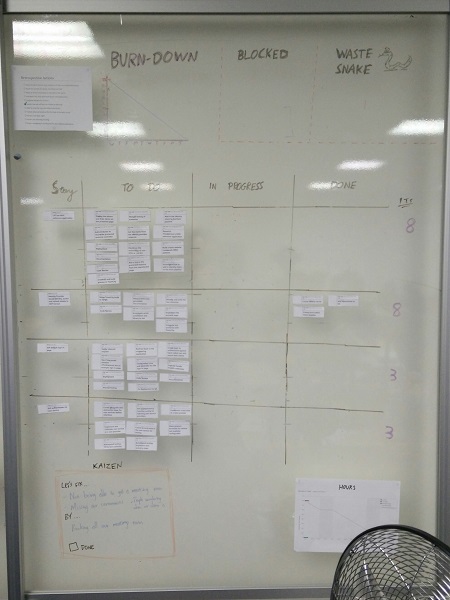Working with both physical and electronic progress boards
Yesterday in a retrospective one of my teams asked a question which is all too familiar:
"Updating both a physical board and an electronic board to track our progress is a bit annoying - can we get rid of one of them?"
So we had a bit of a discussion, with the end result that half the team absolutely did not want to stop having an online JIRA board... and the other half absolutely did not want to stop having a physical board on the wall.
It's been a common pain point whenever I've worked with a team that has two boards to deal with. And I haven't yet found a good answer, as in a lot of environments you do find yourself needing both.
Reasons to have a physical board:
This is our board:

It's the start of the sprint so we've not been able to make a proper mess of it with tickets and working notes everywhere, but you can see just how much information we can represent on even a small whiteboard, and how easily we can change it around to fit our needs.
Some of the good points:
- It's an information radiator. Our progress isn't hidden in JIRA or Trello, it's visible from across the office to anyone who might be interested in the project.
- Resolution is infinite. I never have to scroll through multiple pages to find something on a physical board. You can track lots of information in one place.
- If we want to track some new piece of information, we just write it down. No need to find a plugin or go editing a field configuration.
- It's fast. There's no waiting for a page refresh, or having to navigate through multiple screens to update it.
- It's a good focal point for the daily Scrum.
- Speaking of the daily Scrum, it avoids device fixation. I hate having a laptop at the daily meeting. It ends up with one person driving and the rest of the team passive, you focus overly on one or two tickets rather than the whole picture, and that's before you start getting the inevitable technical issues with corporate networks. The tactile experience of a whole team moving cards around on a board is infinitely better.
- Being a low fidelity solution means you can concentrate more on the task at hand - you're not trying to battle JIRA workflows while working out where you are in your sprint.
- It's sort of fun. (OK, so maybe that's just me. A scrum master I used to work with once commented, "this really appeals to your sense of OCD, doesn't it?" as I was making some magnetic tape line up perfectly on a team whiteboard.)
Reasons to have an electronic board:
This is JIRA, Trello, Asana, or whatever else you like to use.
- You can look at progress anywhere you have an Internet connection.
- It's easy to generate reports and graphs. Calculating and keeping track of hours-remaining burn-down on a physical board is painful.
- In a regulated environment, having a permanent electronic record of what's been done keeps my change control managers and ISO9001 auditors happy.
- An electronic board has (effectively) infinite space, so if we need to keep track of a big list of test cases or a client requirements document we can.
- It's easier to search something like JIRA than a filing cabinet full of old story cards.
- It's a lot easier for distributed teams to work with something that doesn't have a physical location.
So there are good reasons to use each solution. It's not uncommon for a team to need things from both lists... and ultimately we end up here:

This is something I've seen a lot of teams do with great success, and what I tend to start a team with when they're new to this. We take some pain to update both boards, but then we use JIRA to save effort building all those project burndowns, hours-remaining charts and other things which turn into busywork without a computer to do them for us... while still having a big information radiator in the middle of the office that we can stick things to, move cards around on and scribble designs around the edge of.
Maybe one day we'll all have the money to put something like the Microsoft Surface Hub up in our team area and get the best of both worlds; a retina resolution touch screen that we can play with like a physical board, while still having everything stored electronically.
Until then, we'll have to live with a small duplication of effort if we really want the best of both worlds. And if anyone has found a great solution for keeping two boards up to date with minimal effort, I'd love to hear it!
